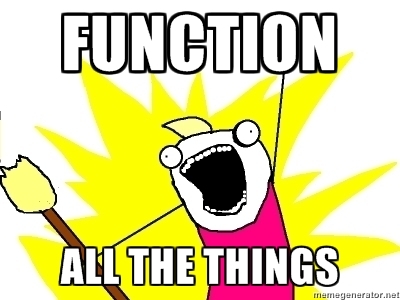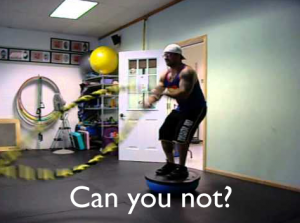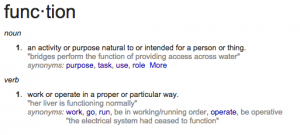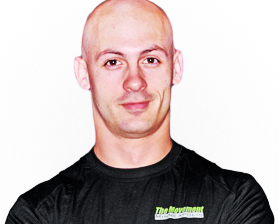
It’s time we take back function, and not just in terms of the bastardized word everyone loves to hate. When it comes to the word “function” and “functional training,” most intelligent trainers roll their eyes and imagine someone standing on a BOSU ball shaking some heavy ropes. They know that just because it’s difficult to remain stable while doing something ridiculous doesn’t mean it’s developing core strength, stability, balance, upper body strength, etc. To the uninitiated it may seem like a good idea but in reality, it doesn’t do any of those things. Many of my peers have spilled words (1, 2, 3, 4) on this topic, so I’m not going to rehash them here.

The impetus behind functional training — the idea that you should train movements that make you more able to complete tasks in sport and life — is sound and commendable, even if it may have risen in popularity only in response to the weight-machine-driven bodybuilding trends of the 70s. The devil is, as they say, in the details.
I’m not going to speculate as to what went wrong with functional training — it’s water under the bridge, as far as I’m concerned. What I’d like to do is take back the word function and tell you why it’s the single most important word as it relates to your training.
If you’ll forgive me for dragging out the old dictionary definition trope, I think it will be instructive:

A function is essentially an ability or capability to do something. You are a collection of cooperative functions at any level of magnification from which you care to look. Starting at a high level with a few examples: You are able to integrate socially at work or in school, you’re able to procure sustenance and necessities like food, water, and shelter to keep you alive, you’re (hopefully) able to provide some sort of value to the rest of the world with the work you do, and you are able to maintain yourself physically with exercise. Within each one of these enormous categories, you have functions that make up the higher-level function. Socially, you may have functions for meeting new people and functions for maintaining existing relationships. In terms of physical maintenance, you have this whole subset of functions we spend so much time talking about.
Knowing how and being able to lift weights in general is a function. The ability to deadlift is a function. The ability to extend the hips (hip extension) is a function, as is the ability to maintain spinal alignment against resistance. Along with the function of knee extension, shoulder retraction, finger flexion, thumb flexion and adduction. And further to that the ability to produce muscular force is a function consisting of a series of chemical reactions and processes inside the muscle.
Guess what happens when you lack a function? Let’s say, for example, you lack the function of insulin secretion to moderate an influx of sugar. That’s a disease called diabetes, and it causes lots of problems.
Sometimes a lack or failure of a function causes serious repercussions and a cascade of failures or hyperactivity in other systems that rely on the missing function. In other cases, a lack of function can go completely unnoticed.
As I said earlier, you are a collection of cooperative functions. Some of them are incomprehensibly specific (operating at a cellular level, for example) and others are so high-level and obvious that they don’t seem to even bear mentioning, such as breathing.
Everything you do or need to do is a function.
There are two general directions you can take this perspective on function. The first is perhaps the most obvious and that is to acquire new but not necessary functions. For example, strength or the ability to accomplish a particular strength feat. In these cases, it can help to think in terms of the functions that are required. For example, if one wanted to successfully lift the famed Thomas Inch dumbbell, he or she would need all of the associated functions to a 175-pound one-arm deadlift, and in addition they would be wise to train the adduction function of the thumb, given that it is a primary limiting factor when it comes to picking up the ol’ Inch.
It’s not critical to your survival to acquire or gain these functions, but it might make you a more capable or useful human. Personally, I’m a fan of collecting more useful and cooperative functions and I enjoy being a sort of Renaissance man rather than being incredibly specialized in one specific thing. I’m happy to be a jack of all trades, but I digress.
The other, and I believe more interesting and more important path is the resolution of missing functions that are causing problems.
If you think it would be a good idea to deadlift, but you lack the function of hip extension (hypofunction in hip extension) it may not mean you lack the function to perform a deadlift but that you’re going to find some other way to perform the deadlift, probably to your detriment when your spinal muscles (hyperfunction) do all of the heavy lifting instead (pun intended.) If that sounds like a compensation to you, well, sure. I’d refer to it as hypo (under) or hyper (over) function.
Pain, especially chronic pain, is a hot topic and while I won’t claim to have definitive answers, I will tell you this: In my experience, there is no clearer association to pain than loss of function. And, in the vast majority of cases I have worked with, a restoration of missing function comes with a concomitant reduction in pain. Could it be that otherwise unexplained pain is an action signal to restore lost function?
When there is a problem, the first place to start looking is what functions you’re lacking. When looking for missing function it’s important to look no smaller than necessary. For example, if someone is missing hip extension I am not going to go looking for problems impeding myosin and actin at the muscular level until I have ruled out getting the numerous moving parts levels above that moving first.
On some level, you are missing functions. Whether or not they’re critical to your daily pursuits varies, but it’s not a question of whether or not you have hypo-functions. Oftentimes the things you do the most often result in hypofunctions in the things you conversely don’t do often enough. This isn’t a problem until it’s a problem. When it is a problem, I believe you’ve now got the paradigm to fix it.
Let’s take back function. Both the dirty word, and the functions we’re missing in the pursuit of better.


Hypo and hyper function is an excellent way to frame why function may be lost and why it may manifest as unexplained pain. To me it reminds me of atrophy. What you do- you keep, and what you don’t do- you lose.
I’ve been having reocurring back pain from a deadlifting accident 1 year and a half ago and I can’t think of a way to fix it. I thought massaging the muscle might work, and it didn’t. I’ve been thinking of trying acupuncture and a variety of other methods to help me out, but maybe I need to work on making sure my hips are doing most of the work when I lift from the floor.
Takeaway: “When there is a problem, the first place to start looking is what functions you’re lacking. When looking for missing function it’s important to look no smaller than necessary.”
Think of it in terms of what needs to be moving, and what needs to be staying relatively still. Hips should move, knees should move, spine should NOT move.
Thank you. I’d like to get it looked at by someone knowledgeable. My back is extremely important to me. Could you recommend someone near NY to look at this? If not maybe a specific type of professional?
Let me see who I can turn up.
“When there is a problem, the first place to start looking is what functions you’re lacking. When looking for missing function it’s important to look no smaller than necessary.”
I really enjoyed that paradigm frame, thank you! I’ve never posted anything before, but felt compelled to say thank you for such a clear and well thought-out post. I feel that paradigm puts the power back in our court and demystifies the steps we need to take to improve. Nice job and thanks again!